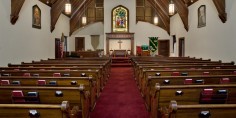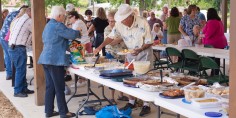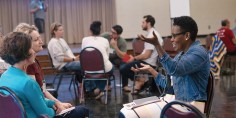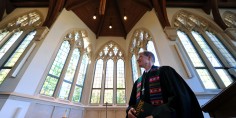During Seeds of Change workshops, pastors and lay leaders gauge how their buildings and land are being used. They study maps and demographics to learn more about pressing challenges in their communities. They share ideas and leave with action plans to discuss back home.
The congregation Bayne visited, for example, might decide to open their parking lot for a weekly farmer’s market; the fellowship hall could become the only local coffee shop. The church might rent space to a chef who needs a commercial kitchen to begin a catering service, or allow a theater group to use the stage for practice space.
“We want the workshops to give them ideas for doing the exciting ministry that more and more of our congregations are waking up to,” she says.
Churches begin Seeds of Change by calculating the percentage of time their facilities are used during the week. On average, it’s 14 percent. Robb Webb, director of the Endowment’s Rural Church program area, says the Endowment is measuring the success of the program by tracking that figure over the years.
“We know this work may take time and that ideas planted today may take a year or two to germinate,” he says. “We encourage churches to get started, recognizing that their buildings can be an important asset that leads to meaningful change in the community.”
‘Need to do Something’
Twenty-one churches have participated in Seeds of Change, with another training session scheduled for this month. One congregation opened a co-working area where people can escape the isolation of working from home. Another modified a building to help the food bank provide meals. In Gaston County, a congregation is transitioning its church into offices for local nonprofits.
Several other projects are in the pipeline, including:
- Redeveloping a 20,000-square-foot building on church property to house a mix of retail and offices. The building will generate income and provide much-needed space for services such as counseling.
- Redesigning space for a modern worship service, which now takes place in the gym. The modification will allow recreational leagues to use the gym again, and the modern worship room will also be used for community concerts and recitals. In addition, the church is reformatting its kitchen for community rentals.
- Redesigning a building and adding a small area to allow the congregation to expand its partnership with the YMCA by moving music and other classes into the church.
- Taking a closed church and revitalizing its property into a campus for a fast-growing immigrant congregation that had been sharing space with another congregation. A multi-use addition will host community events and educational programs.
“Few, if any, churches change overnight,” Gilland says. “For many congregations, the realization that they need to do something different takes time to understand and accept. Our goal is to plant seeds of possibilities and be there to assist those who are ready to move to the next step.”
A Bigger Role
At Goldston, Seeds of Change helped church members develop land that had been purchased five years earlier. After testing ideas during the workshops, they interviewed school officials, business owners and the sheriff to hear what they would do with the property.
“The program focused our thinking on how our nine acres could benefit our neighbors,” Pastor King says.
Still in the planning stage is a half-mile trail that will circle a pond on the grounds. Since the town has few sidewalks and hiking paths, the church hopes people will visit the trail for exercise and strolls.
The garden, now in its second season, is already giving the church a bigger role in the community. Everyone is invited to harvest on Wednesdays and Saturdays, and anyone can stop by for free okra, cucumbers, tomatoes, collards and potatoes. Goldston also delivers vegetables to a nearby soup kitchen and food pantry; the church’s second-annual Tomato Sandwich Supper drew 80 people from the congregation and beyond.
“When we first started planting, I wasn’t sure if it would amount to anything,” Pastor King says. “But it’s just amazing to see how productive this garden has been. It’s exciting to be able to share what God gives us.”





